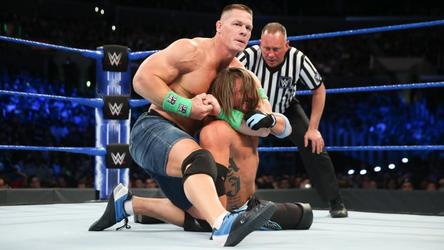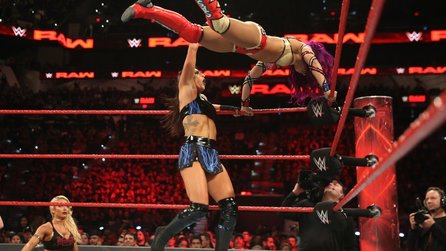Written by Joel T. Lewis A lot changed for me last year: I finally got to see The Last Jedi, Max Bemis took over Moon Knight, and it was the year I fell in love with professional wrestling. That’s right dear readers, buckle up because what you’re about to read may shock you, and in a sense, that’s what I want to talk about. Why do we scoff at the WWE? Why did I hate pro-wrestling? It’s probably the demographic right? That’s the negative image we associate with the sport (and I am not using that term ironically); the obscenity spouting, often-spitting, mouth-breathing red-necked masses waving their beer soaked middle fingers at hulking alpha males who proceed to pretend to hit one another. And to a certain extent, that’s fair enough. From its golden age leading into the Attitude era, pro-wrestling was far from the most woke entity; trading on racist, sexist, and homophobic story angles for quick and dirty ‘character development.’ It employed cheap small-minded prejudices in order to quickly establish good guys or face characters and bad guys, also called heels. This method of character development doesn’t appeal to, or even target the most upstanding fan base, and this fuels much of the negative view of wrestling fans in popular culture. It certainly did for me. It also didn’t help that when I was a kid I was bullied by guys in Steve Austin and Undertaker t-shirts, so that definitely contributed to my avoiding the wrestling world. But in recent years the WWE has become more progressive. In the last 2 years the women’s division of the WWE has grown leaps and bounds from the overly sexualized Diva’s Division of the past. Female superstars are now featured as main event performers at WWE pay per view events with their own Hell in a Cell, Royal Rumble, and Elimination Chamber matches. Their evolution from objectified sideshow characters to legitimate main event performers is very exciting and has inspired a whole new generation of female wrestling fans. Pro-wrestling has also move away from the days when broadly drawn racial stereotypes informed a character’s performance and rivalries. Another criticism you hear is that it’s fake. Why do you care about a fake sport? How can you be invested in an event claiming to be a fight when punches don’t land, matches are choreographed, and the finishing moves are too cheesy to believe that they could really hurt? Again, this is a fair argument. It is definitely more difficult to suspend your disbelief watching wild haymakers that don’t really connect in wrestling when choreographed fights in movies and TV are edited and enhanced to sell the blows more believably.  Now, as a more than casual sports fan I have always been attracted to the pageantry of Game Day. The Super Bowl, title defenses in Boxing, the World Cup Finals; I love the ritual of a whole day devoted to a sporting event. You have people over, they wear jerseys, you eat specific food (often bad for you which is a plus), and it’s a great communal, almost tribal experience. In an odd way it feels like family. That being said, you can’t talk about game day rituals without talking about pay per views and their problems. PPV’s are expensive and more often than not the matches that cost you over $100 amount to 4 hours of mid-card bouts that you tune in and out of and a main event that turns out to be anticlimactic. This is especially true of UFC matches, because of the nature of takedowns and submissions, a title match could be over in less than a minute. So you have this huge build up to a disappointing ending, and that’s frustrating. Even with baseball, hockey, football, and basketball there’s no guarantee of a photo finish or a satisfying climax to a dramatic season. That’s not to say that that doesn’t happen, just that it is not a given. What I found with the WWE is that because matches are “scripted” (not “fake”) the payoff of a title match is massive. Because the matches are components of a larger story and the outcome is predetermined, at the end of a PPV, whether who you were rooting for wins or not, you feel as though you got your money’s worth. The object of the wrestling match isn’t really who comes out on top, it’s about the highs and lows within the match, the ebb and flow of the competitors’ momentum, and selling the story of the fight. These are the same factors that we love about the Rocky and Creed films. Rocky wasn’t a real fighter and he never fought like a real fighter (anybody with guards that low would have been decimated), but what we enjoy about those movies and the fights within them is the drama, the story they represent. The final criticism I want to examine has to do with the ridiculousness of the characters and their personas. Hulk Hogan, Macho Man Randy Savage, Undertaker, and John Cena were and are grown ass men who dress up in ridiculous outfits, commit to silly character catchphrases, and feud with each other over fictional and imagined slights. They do. That is a major component of the WWE. Look, as a manic Moon Knight fan specifically, or even a superhero fan in general I can’t look down on the WWE for those reasons. It’s a fictional universe filled with colorful, outrageous, and over-the-top characters, who actually have superhuman physiques and gymnastic abilities. The only real difference between the two is that when you see a Wrestler dive from the top rope or slam into the apron in a match, there’s no cgi involved. Admittedly, the writing of comic book characters is consistently better but the ethos is the same. My point is, I’m a wrestling fan and I fully expect to catch some heat as a result of this. But if I’m honest, it’s really hard to claim that wrestling fans aren’t nerdy and that’s what this site and I am all about. So until next time, Geek On!
0 Comments
Leave a Reply. |
Archives
December 2024
|
|
© 2012-2025, Nerds That Geek LLC.
All Rights Reserved. |
uWeb Hosting by FatCow

